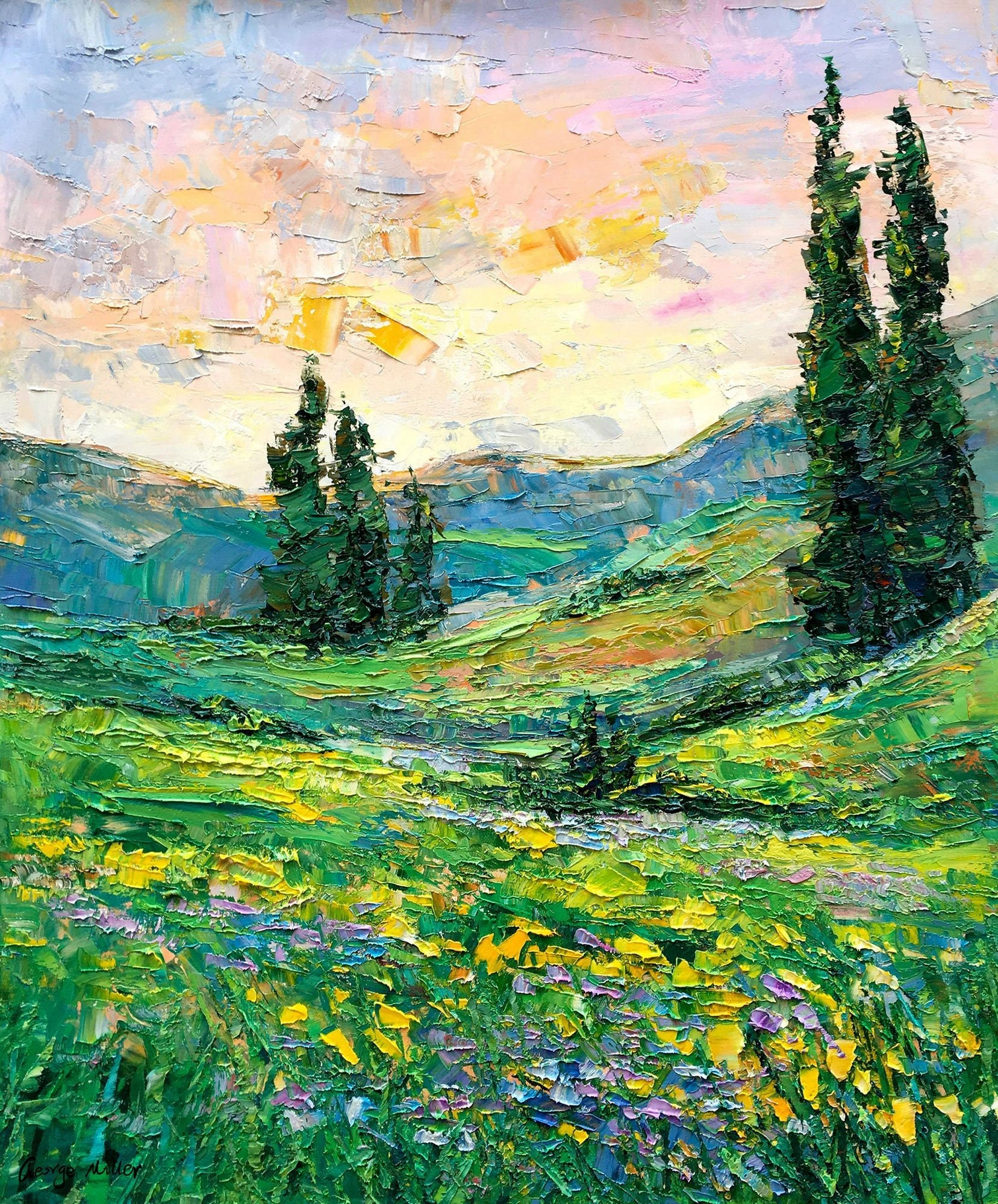Exploring All Concerning Oil Paintings: A Guide to Recognizing Their Beauty and Worth
Oil paintings have captivated target markets for centuries, providing a peek into the creative mastery of numerous ages. Their abundant background is linked with innovative methods and profound psychological expression. Recognizing the products and methods behind these art work can enhance appreciation. Furthermore, the market for oil paintings provides possibilities for capitalists and collectors alike. As one discovers this remarkable globe, the concern develops: what makes an oil paint genuinely beneficial?
The History of Oil Paint: A Journey Via Time
Although oil paint has roots that date back to ancient times, it genuinely prospered during the Renaissance, when musicians uncovered its versatility and abundant shade potential. Early examples can be mapped to the 7th century, with techniques advancing especially across cultures. The medium ended up being prominent in Northern Europe in the 15th century, specifically with the jobs of musicians like Jan van Eyck, who originated its use for comprehensive realism and vivid colors. This duration noted a departure from tempera paints, permitting better deepness and appearance. As oil painting spread, it influenced numerous artists, bring about masterpieces by popular numbers such as Leonardo da Vinci and Rembrandt. The medium's heritage continues, forming the art world well into contemporary times.
Understanding Oil Paints: Materials and Techniques
As musicians discover the world of oil paints, they experience a varied array of products and methods that specify this tool. The main components of oil paint include pigments, which provide shade, and drying out oils, such as linseed, that bind the pigments and promote application. Numerous additives can modify the paint's texture and drying time, enhancing adaptability. Strategies like glazing, where clear layers are developed up, and impasto, which involves applying thick paint, enable various visual impacts. In addition, the usage of brushes, palette knives, and even fingers can create one-of-a-kind appearances and coatings. Recognizing these materials and methods allows musicians to completely share their imagination and attain the wanted impact in their artwork.
The Function of Color in Oil Paintings
Shade plays a crucial function in oil paints, affecting both aesthetic allure and psychological vibration. Understanding shade concept basics, consisting of the connections in between shades, can boost an artist's capability to share mood and atmosphere. Furthermore, understanding color blending techniques enables better deepness and richness in a painting's combination.

Shade Concept Basics
Comprehending shade concept is important for artists functioning with oil paints, as it forms the structure for developing aesthetically interesting and unified make-ups. Color theory encompasses the research of just how colors communicate, the color wheel, and the connections between primary, additional, and tertiary shades. Artists utilize corresponding shades to enhance contrasts and create centerpieces, while comparable shades advertise unity and cohesiveness within a piece. Furthermore, the ideas of awesome and cozy colors affect the understanding of deepness and space in a painting. Grasping these concepts permits musicians to manipulate color properly, guiding the audience's eye and connecting their intended message. Mastery of color concept eventually enriches a musician's capability to communicate emotions and concepts via their work.
Emotional Effect of Shade
The psychological impact of color in oil paints plays a crucial role in just how visitors connect and perceive with artwork. Shades evoke certain sensations and state of minds, influencing the audience's psychological state. For example, cozy colors like reds and oranges can develop a feeling of warmth and power, while cool tones such as blues and environment-friendlies typically stimulate peace or self-contemplation. Artists tactically pick shade palettes to improve narrative aspects, leading the target market's emotional trip. The saturation and comparison of shades better magnify these impacts, drawing focus and producing emphasis. Inevitably, the interplay of colors in oil paints not just boosts their aesthetic allure but also offers as a powerful medium for emotional expression, enhancing the audience's experience and interpretation.
Shade Mixing Techniques
While many aspects of oil paint add to the total make-up, mastering shade blending strategies is necessary for accomplishing wanted effects and depth. Color blending can be come close to through different methods, consisting of the additive and subtractive processes. Additive blending includes integrating colors of light, while subtractive mixing relies upon pigments, where colors mix to create brand-new tones. Artists commonly make use of a minimal combination to produce harmonious works, understanding the relationships in between primary, second, and tertiary shades. Strategies such as glazing and scumbling even more enhance depth and luminosity. By skillfully blending shades, an artist can stimulate emotions, develop centerpieces, and accomplish a feeling of realistic look, inevitably elevating the painting's aesthetic and psychological influence.
Famous Oil Painters and Their Iconic Functions

Renowned for their mastery of shade and technique, oil painters have actually created a few of the most popular art work in background. Popular musicians like Vincent van Gogh astounded target markets with his emotive brushwork in "Starry Evening," while Claude Monet's "Impact, Dawn" laid the foundation for Impressionism. Leonardo da Vinci's "Mona Lisa" continues to be a long-lasting sign of imaginative brilliant, showcasing his ability in catching human expression. Rembrandt's "The Night Watch" shows his innovative use of light and shadow. Various other significant figures include Pablo Picasso, that transformed modern-day art with his bold trial and error in jobs like "Les Demoiselles d'Avignon," and Georgia O'Keeffe, whose lively depictions of blossoms and landscapes helped define American modernism. Each artist's one-of-a-kind design added considerably to the oil painting landscape.
Exactly how to Review the Quality of an Oil Paint
Reviewing the top quality of an oil painting entails a careful evaluation of workmanship methods, as well as an evaluation of color and more info structure. Observing brushwork, layering, and the application of paint can expose the artist's ability degree. In addition, the interplay of colors and the total arrangement of elements contribute significantly to the painting's visual worth.
Evaluating Craftsmanship Strategies
A thorough analysis of workmanship techniques is necessary for determining the high quality of an oil paint. Critics should first take a look at the application of paint; thick, textured brushstrokes may recommend a competent hand, while extremely uniform applications might suggest a lack of deepness. oil paintings for sale. The layering method is also crucial; the presence of glazes and differed thickness can boost luminosity and complexity. Furthermore, the quality of the products used, such as the canvas and pigments, plays a significant function in sturdiness and general visual. Focus to information in elements like sides and changes between shades reflects the musician's commitment to their craft. Eventually, these techniques add to the painting's emotional influence and market value, acting as signs of the musician's ability and intent
Evaluating Color and Composition
While evaluating the high quality of an oil paint, one must concentrate on the interplay of color and structure, as these elements are basic to the artwork's general influence. Color selections can evoke emotions and establish mood; as a result, the musician's palette must be checked out for harmony and contrast. A well-balanced composition directs the visitor's eye and produces a feeling of unity. Artists typically employ methods like the guideline of thirds or leading lines to enhance visual passion. Furthermore, the use of light and shadow can include deepness, improving the three-dimensionality of the painting. Ultimately, a successful oil paint marries color and composition, engaging the audience and inviting a much deeper gratitude of the musician's vision and technique.
Caring for and Preserving Oil Paintings
Proper care and preservation of oil paintings is necessary for preserving their stability and long life. To secure these art work, it is vital to show them away from straight sunlight, which can trigger fading and discoloration. Keeping a steady setting with controlled temperature and moisture further aids in preventing damage. Cleaning ought to be done carefully using a soft, completely dry cloth, preventing any type of severe chemicals that might harm the paint or varnish. Normal examinations for signs of degeneration, such as flaking or cracking, are a good idea. When moving or keeping oil paintings, proper cushioning and framework are essential to avoid physical injury. Inevitably, thorough treatment contributes to the aesthetic charm and value of oil paintings with time.
The Marketplace for Oil Paintings: Accumulating and Spending
Comprehending the marketplace characteristics for oil paintings is important for enthusiasts and financiers alike. The value of these artworks is influenced by different elements, including the artist's reputation, historic value, and existing trends. Collectors typically look for pieces that resonate directly while taking into consideration prospective recognition in value. Galleries and auctions act as main places for trading, with costs varying based upon demand and rarity. Purchasing oil paints needs research study into the market, as well as an understanding of credibility and provenance. Additionally, arising artists may offer possibilities for substantial returns, while established names can regulate high rates. Overall, a strategic approach to accumulating can yield both aesthetic satisfaction and economic benefits.

Often Asked Concerns
What Are the Environmental Effects of Oil Painting Materials?
The ecological impacts of oil painting products consist of the launch of unstable natural compounds (VOCs), hazardous waste generation, and source extraction for pigments. These elements add to contamination and ecological degradation, raising concerns amongst ecologically mindful artists and customers.
Just How Do Various Canvases Influence Oil Painting Results?
Different canvases affect oil paint results considerably. Surface, structure, and absorbency top quality can modify paint application, drying out times, and shade vibrancy. Artists typically pick certain canvases to attain wanted results and enhance their imaginative expression.
Can Oil Paintings Be Recovered if Harmed?
Oil paintings can certainly be brought back if damaged. Specialist conservators use numerous methods to repair tears, clean surface areas, and address staining, ensuring that the art work preserves its initial charm and worth for future generations.
What Are the Indications of an Initial Oil Painting?
The indications of an initial oil painting include visible brush strokes, texture variants, and an unequal canvas weave (oil paintings for sale). Additionally, credibility might be confirmed via provenance, signatures, and the presence of a varnish layer special to oil tools
Just How Has Innovation Influenced Modern Oil Paint Techniques?
Technology has substantially influenced modern-day oil painting methods by presenting digital devices for preparation, boosted materials for structure and longevity, and on the internet platforms for sharing and offering art, therefore increasing musicians' innovative opportunities and audience get to. Oil painting has origins that date back to old times, it absolutely flourished throughout the Renaissance, when artists uncovered its adaptability and rich shade potential. The psychological impact of shade in oil paintings plays an important role in exactly how audiences attach and perceive with art work. While lots of elements of oil paint contribute to the overall make-up, grasping color blending techniques is essential for attaining wanted results and deepness. Reviewing the top quality of an oil painting involves a mindful evaluation of workmanship strategies, as well as an evaluation of shade and composition. While evaluating the top quality of an oil paint, one need to concentrate on the interaction of shade and composition, as these aspects are essential to the artwork's total influence.